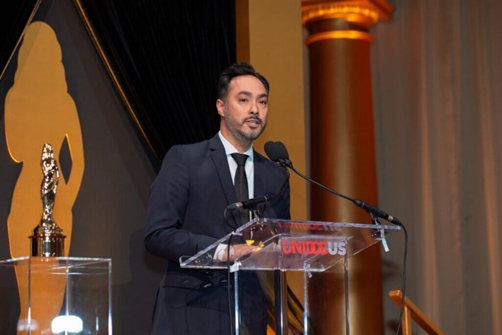From Analysis to Action: Launching US History Lesson Plans inclusive of Latino Contributions
May 16 marked a year since the release of our collaborative report with the Johns Hopkins Institute for Education Policy Analyzing Inclusion of Latino Contributions in U.S. History Curricula for High School. As we reflect on the implications of the study on this anniversary, we are proud to share the progress that has been made since and the actions we are taking to ensure meaningful inclusion of American Latinos’ longstanding contributions to our country.
By: Viviana López Green, UnidosUS Senior Director, Racial Equity Initiative
Background
Hispanics have been an integral part of the American story for hundreds of years dating back to the origins of the United States. Yet United States history textbooks all but omit our presence, contributions and experiences over many centuries as being an integral part of the American fabric.
In 2021, Rep. Joaquin Castro (TX-20) commissioned a U.S. Government Accountability Office (GAO) report on Latino representation in the media — including news outlets, Hollywood and publishers. UnidosUS presented Rep. Castro with an ALMA award earlier this year for his groundbreaking work in this area. In his acceptance remarks, Rep. Castro shared what inspired him to explore Latinos’ invisibility across media sectors:
“I decided I was going to work on Latino exclusion in media when a madman, in August of 2019, drove 10 hours and killed more than 20 people in my home state…because he considered them “Hispanic invaders…” I asked myself: How does somebody who has no experience with the Latino community, didn’t grow up around us, didn’t work with us, come to believe that Latinos – who have been here forever – are invaders to the United States and to Texas? I believe that one of the answers is the fact that we’ve been made invisible in American media…and in the teaching of American history.”

Rep. Castro went on to explain that in preparing for the GAO report, he and Congressional Hispanic Caucus colleagues met with the Association of American Publishers in 2020. When Rep. Castro asked the CEO of one of the top publishing companies in the country about American Latinos who’ve had a significant impact on U.S. history, the Ivy League educated CEO — who sells textbooks to our public schools and universities — could not name a single one. And that is just one example that proves why the issue of Latino inclusion in U.S. history curriculum is so crucial.
Our work in the Racial Equity Initiative over the last four years closely relates with Rep. Castro’s efforts on Latino visibility in the media. When we released Analyzing Inclusion of Latino Contributions in U.S. History Curricula for High School in partnership with the Johns Hopkins Institute for Education Policy one year ago, this first-of-its-kind, comprehensive analysis of Latinos’ portrayal in widely used U.S. history textbooks revealed a failure to cover many seminal events in the American Latino experience.
The report served as a first step in documenting the extent, quality and variety of classroom content about Latinos’ contributions and experiences in shaping our country that are reflected in existing curricula. We found that 87% of key topics in American Latino history were either not covered in the evaluated books or mentioned in five or fewer sentences.
Specifically, only 28 of 222 important topics were covered well, leaving out many crucial aspects of Latino history, including the Mexican-American War, the Spanish-American War, the U.S. acquisition of Puerto Rico, the Panama Canal, the modern civil rights movement, and more. In all, the books included just one Hispanic breakthrough moment from the last 200 years: Sonia Sotomayor’s appointment to the Supreme Court.
Why This Matters
Today’s classrooms include nearly 14 million Latino children, representing more than 25% of all K-12 public school students. Students are more likely to engage and achieve when they learn about the accomplishments of people like themselves, and they are more likely to understand others when they encounter diverse narratives and perspectives. The bottom line: greater inclusion of marginalized communities in textbooks and curricula doesn’t just benefit Latino students; it improves the achievement of all students.
As the U.S. grows more diverse, it’s essential for our future workforce, entrepreneurs, community leaders and public officials to learn about the contributions and experiences of all Americans, including Latinos, who are the country’s largest racial/ethnic minority and comprise almost 20% of the U.S. population. Current Latino-focused content in U.S. history and social studies textbooks falls far short of what should be required in a country where the proportion of the Hispanic population is expected to grow to 29% by 2050.
Recommendations
Our report included recommendations that all educational stakeholders can follow to expand students’ exposure to content seminal to the Latino story:
- Publishers can commission independent reviews of their materials and bring Latino scholars into the design process.
- State and system leaders can establish clear expectations that K-12 curricula should reflect accurate and inclusive Latino-focused content.
- Teachers and parents can advocate for high quality, culturally representative materials.
While curriculum topics are under increasing political scrutiny, it is critical to understand what and how students are being taught. Latino-focused content in high school history books falls far short of the ideal today, but all of us can use the findings of this project to more accurately convey the compelling role that Latinos have played, and continue to play, in our national story.
Looking forward
Since releasing our analysis report one year ago, we have been working with the Gilder Lehrman Institute of American History – whose work is often cited as the gold standard for U.S. history education – to jointly create, curate and distribute high impact lesson plans and resources. The first lesson plans to be released cover a few of the many essential topics related to Latino history, including immigration, the Latino civil rights movement, and Latino pioneers.

The lesson plans, covering the seminal Latino content identified by experts and referenced in our report will be released in June and July 2024 on the Institute’s website, to a network of over 35,000 schools and more than 80,000 teachers. Additionally, the Institute will offer a professional development seminar this summer to help teachers incorporate Latino contributions into their American history lessons.
Through our work with the Institute, including teacher surveys, we learned where we can start moving the needle; thus, even as we continue to focus on longer-term systemic changes to ensure more inclusive educational materials for all kids, providing lesson plans to educators is a second step in the long journey to close the gap on American Latino history content. These actions represent the foundation of our plan to ensure Latino history is not only included in curricula but, beyond that, is made a priority.
Without visibility in news coverage, academia, and educational materials, the influences, challenges, and needs of our community are often overlooked, or poorly understood, by policymakers, our allies in the fight for racial equity, key decision-makers like textbook publishers, and the public in general. We believe that this work will draw national attention to Latino communities and enhance the creation of evidence-based policies and interventions that result in a more equitable society.
We hope the findings from the analysis report – and subsequent action steps – spark national efforts to reframe how our contributions to the nation are taught in K-12 schools and inspire an understanding of the unique role American Latinos play in U.S. history.

